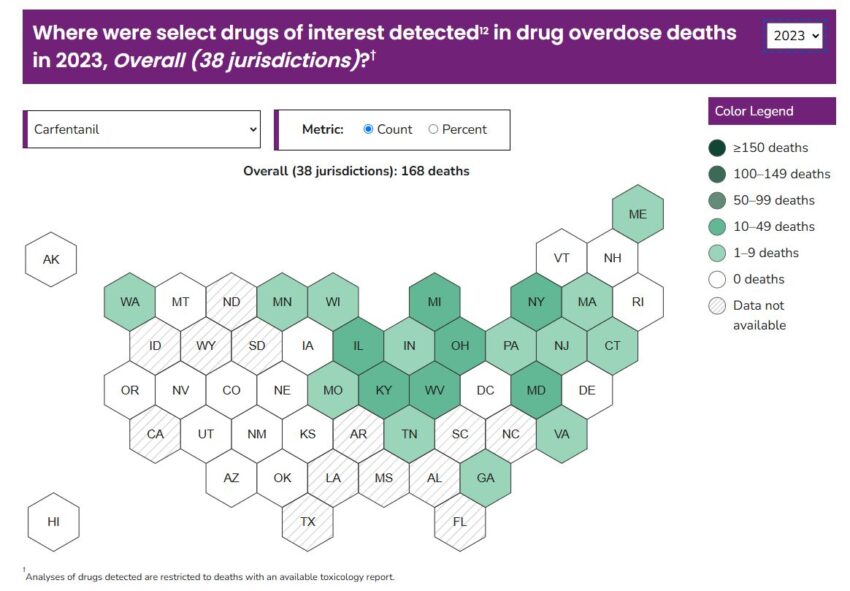A report, Detection of Illegally Manufactured Fentanyls and Carfentanil in Drug Overdose Deaths — United States, 2021–2024, published on December 5, 2024 in the CDC’s Morbidity and Mortality Weekly Report (MMWR) warns of increasing drug deaths caused by carfentanil.
Carfentanil is a synthetic opioid that is used primarily to tranquilize large animals such as elephants. It is purportedly 100 times stronger than fentanyl. It was attributed to a rise in deaths in a number of states such as Ohio and Pennsylvania around 2017 before declining. In 2022, according to the CDC database, it was detected in only six of 29 reporting states accounting for just 7 deaths, down from 277 deaths in 13 of 32 reporting states in 2021. The decline has been attributed to increased regulation of sources in China, but others believe the potency of the drug made it too hard to successfully blend into the drug supply without killing too many people.
The latest data from the MMWR report shows carfentanil was found in 238 deaths from January to June 2024 from 37 reporting states up from 29 deaths in January-June 2023. Here in Connecticut, we saw 9 carfentanil related deaths in 2024, up from 7 in 2023, after seeing only three in the previous four years. When we looked at the carfentanil deaths here in Connecticut there was not a corresponding increase in overdoses in the areas surrounding the deaths.
The fact that carfentanil is 100 times stronger than fentanyl is a bit misleading. Potency must be considered in relation to volume. Increased potency but less volume may mean less lethality than a drug with less potency, but much more volume in the mix. The other factor to consider is that 87% of these people also tested positive for fentanyl. Just how much carfentanil was in their fatal mix–barely a trace or a lethal amount– is unknown. The previous carfentanil scares, as the report points out, were very localized and less than 25% also involved fentanyl. In other words, the previous deaths were caused by carfentanil as the active ingredient; now carfentanil appears to be more of an adulterant.
Note: The CDC web site points out that if five drugs are found in a person’s system, all five are “classified as involved in the drug overdose death,” while in practice only one of the five may have been the culprit drug.
While the increasing presence of carfentanil in the drug supply bears watching, it is also important to point out the amount of people dying who test positive for carfentanil is still a very small portion of those dying of opioid overdose. The MMWR report characterizes the carfentanil deaths as “rare.” Deaths in Connecticut and nationwide continue to decline despite this rise in carfentanil.
Health care providers and harm reductionists should keep on doing what they are – warning people that the drug supply is toxic. Whether fentanyl or carfentanil, never use alone and always have naloxone – which works on carfentanil and all other opioids– readily available.

